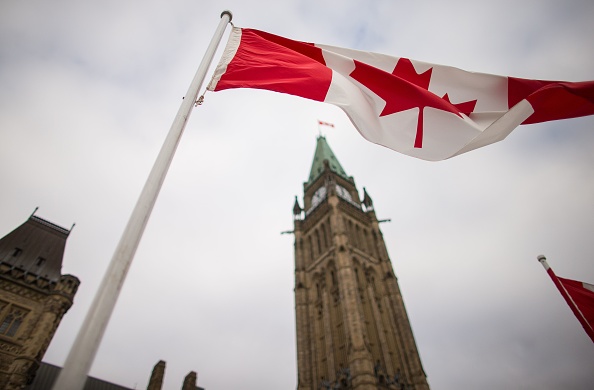
A Canadian flag flies in front of the peace tower on Parliament Hill in Ottawa, Canada on December 4, 2015 in a file photo. (By GEOFF ROBINS/AFP via Getty Images)
By Lee Harding
The federal government is continuing its high-spending ways despite the end of its rationale for doing so, say the Parliamentary Budget Officer (PBO) and others concerned about long-term economic consequences.
“Since the start of the pandemic, the Government has spent, or has planned to spend, $541.9 billion in new measures—almost one third of which [$176.6 billion] is not part of the COVID-19 response plan,” PBO Yves Giroux said announcing his mid-January report commenting on the feds’ 2021 economic and fiscal update (EFU) published Dec. 14, 2021.
The new measures announced in the EFU are largely in addition to the measures included in the Liberals’ 2021 election platform, Giroux said, noting in his estimate that the “remaining platform measures would amount to $48.5 billion in net new spending over 2021–22 to 2025–26.”
Aaron Wudrick, director of the Macdonald-Laurier Institute’s Domestic Policy Program, says the pandemic gave political cover for the Liberals to introduce long-held policy goals, such as more government daycare.
“This is a government that just likes to spend money. They were that way before the pandemic, they’ve been that way during the pandemic, they will be that way after the pandemic. Hope springs eternal that they will show some discipline, but it would be a major change from their track record up until now,” Wudrick said.
The Liberal goal of lowering the debt-to-GDP ratio, a fiscal anchor during its majority term, seem to have since been set aside, suggested Giroux, who said he doesn’t believe that ratio will drop below its current level until 2026–27.
He also questioned why high spending would need to continue when 106 percent of the jobs lost at the start of the pandemic have since been recovered. In 2020 the feds had introduced certain “fiscal guardrails”—benchmarks mainly tied to the labour market—to help determine when to wind down the stimulus.
“The Government’s own fiscal guardrails indicate that stimulus spending should be wound down by the end of fiscal year 2021–22. It appears to me that the rationale for the additional spending initially set aside as ‘stimulus’ no longer exists,” Giroux said in a Jan. 19 press release announcing the publication of his report.
‘It’s Always Hard to Stop Spending’
Malcolm Bird, a political science professor at the University of Winnipeg, says political motivations help spending to continue when economics suggest otherwise.
“There’s a political problem with cutting off the cash,” Bird said in an interview.
“It’s always hard to stop spending because spending gets you votes and is positive. You go out and make announcements and give money to people and ‘Hurray, hurray!’ So spending is fun and chopping spending is not fun. And spending money that you’re borrowing is better than spending money that you have to tax people for.”
Statistics Canada data reported that the year-over-year consumer price index rose 4.8 percent in December 2021, slightly above the 4.7 percent recorded in November and October.
In a mid-December note, RBC suggested that inflation has become more widespread, “with 58 percent of the consumer basket seeing faster than 2 percent annualized price growth in November from pre-pandemic (2019) levels on average over the previous three months.” As transport, labour, and input expenses continue to rise and flow through supply chains, more goods and services will likely be affected, RBC said.
Bird noted that “we’re actually not in an inflationary period. What we are in is prices are rising, standards of living are correspondingly dropping. The dollars aren’t going as far. That’s another thing that I think is adding stress to people.”
The Bank of Canada’s fourth-quarter 2021 business outlook survey, released Jan. 17, noted that most businesses are planning wage increases to compete for workers and retain staff, and Bird expects the same for the public sector.
“I don’t understand why the unions aren’t calling the government out on this and saying, ‘Forget 1 percent [wage hike], we need 5 percent.’ If that occurs … that’ll erase all of that inflationary gain from the revenue.”
‘Watch Out for Tax Increases’
Wudrick says that because Canadians put much of their COVID relief in the bank, the full effects of the “pre-loaded” economic stimulus have not been felt. He has concerns for Millennials in the longer term.
“More spending means higher debt costs, and if interest rates rise, it will be a squeeze on public services. People will get less for the taxes they pay because more money will go to interest payments,” Wudrick said.
“Housing especially has become unaffordable for millions of middle-class Canadians. We have a greying population and workforce and fewer workers per retiree. It all adds up to a challenging future for younger Canadians unless there are major course corrections taken soon.”
The last time budget considerations weren’t shadowed by the pandemic was in 2019, when the Liberals still had a majority and Chrystia Freeland was not yet finance minister. Wudrick said he wouldn’t be surprised if taxes rose.
“The next budget will tell us a great deal about the government’s long-term, post-COVID agenda, so we should watch it very carefully,” he said.
“Watch out for tax increases. The government will start looking for ways to squeeze Canadians for more. It is less a question of if, than of when and which taxes.”